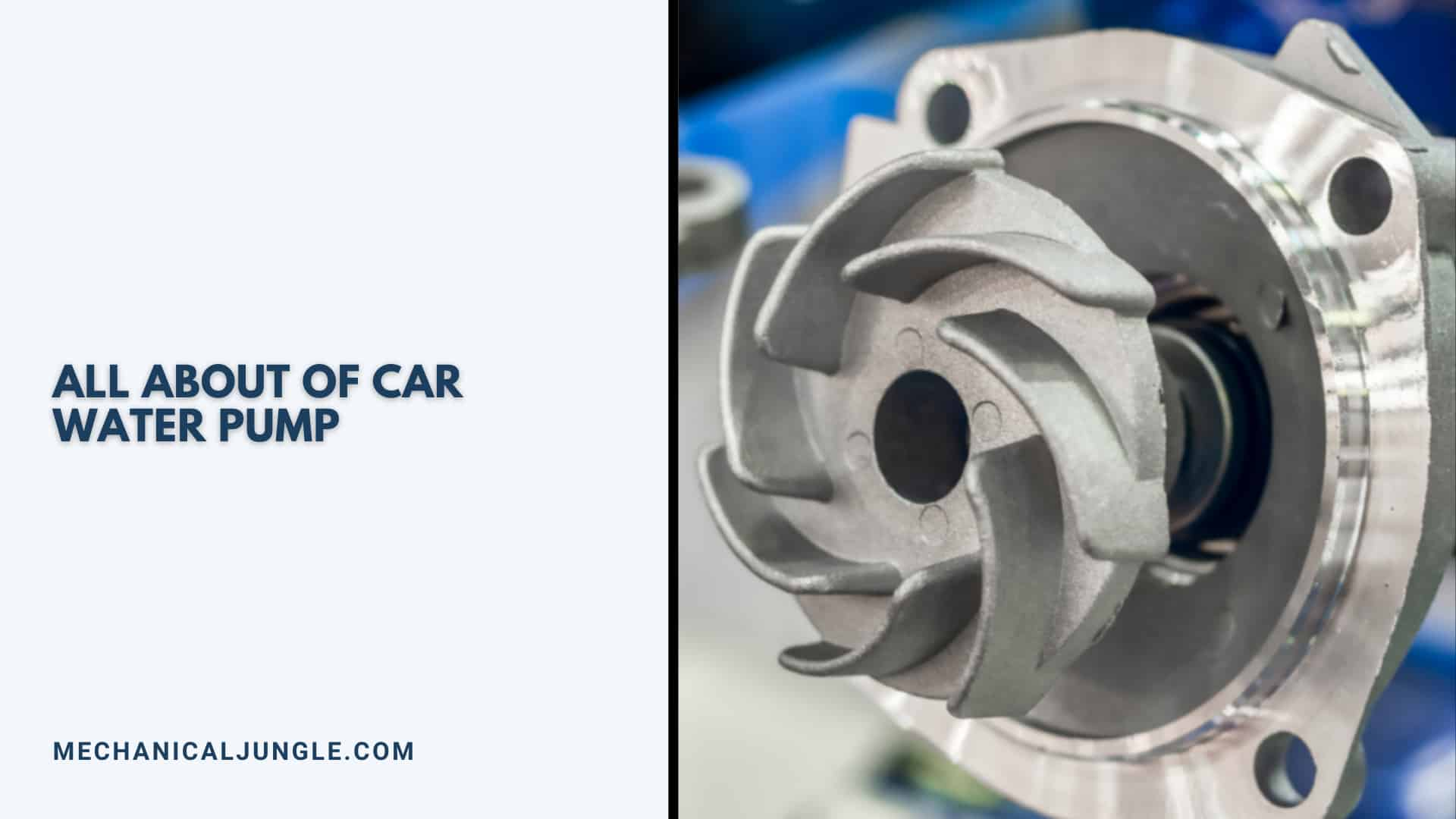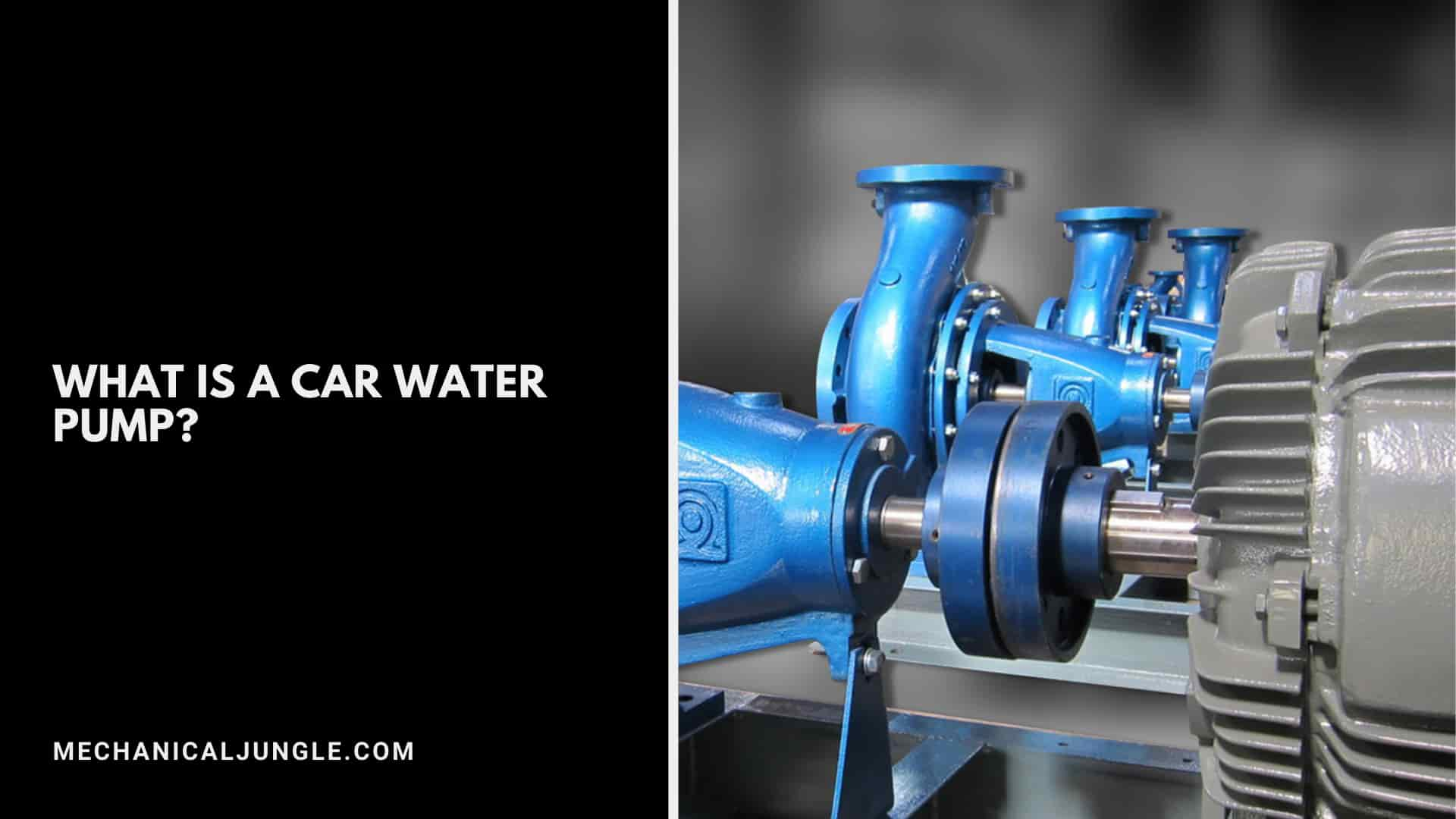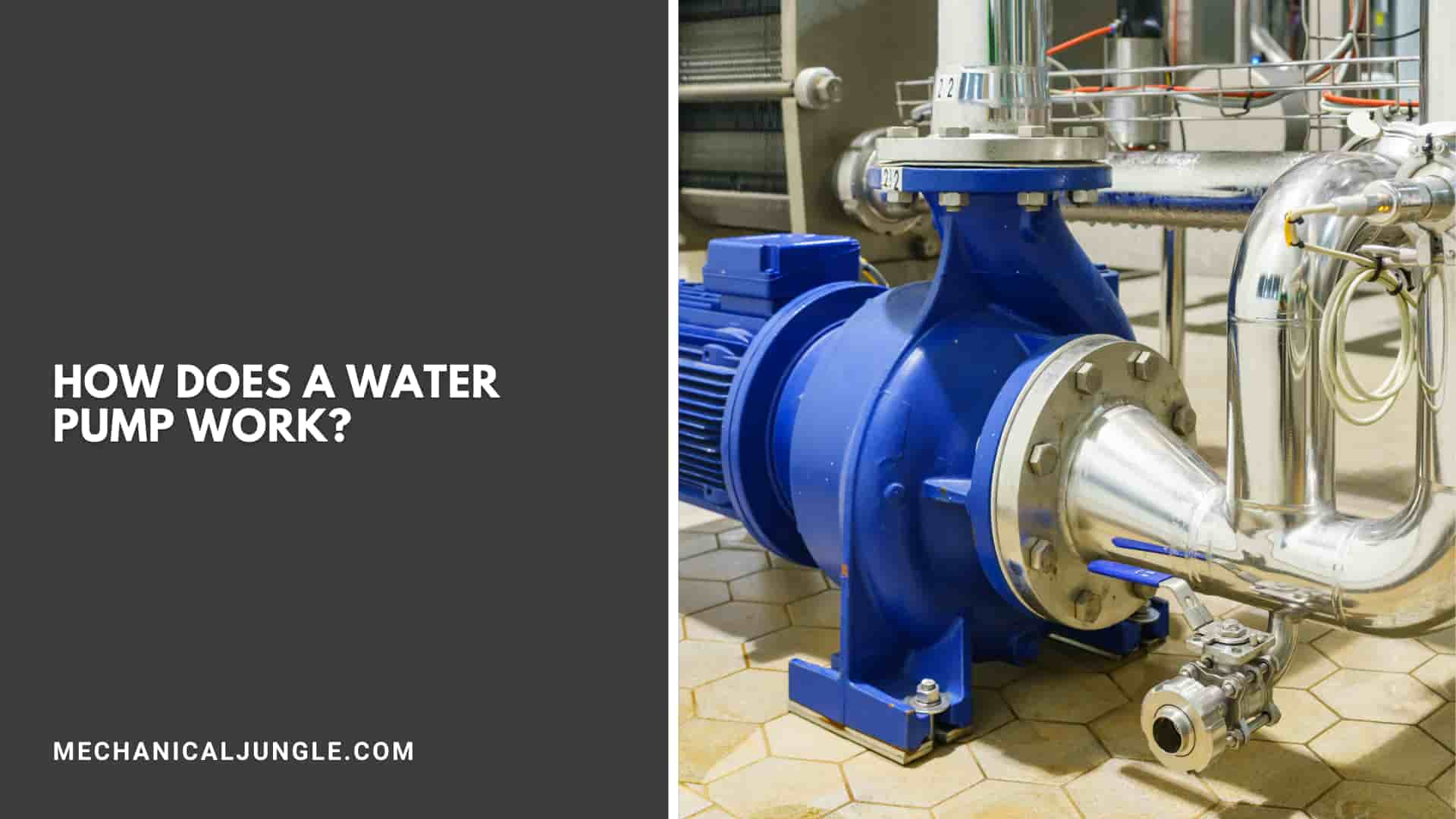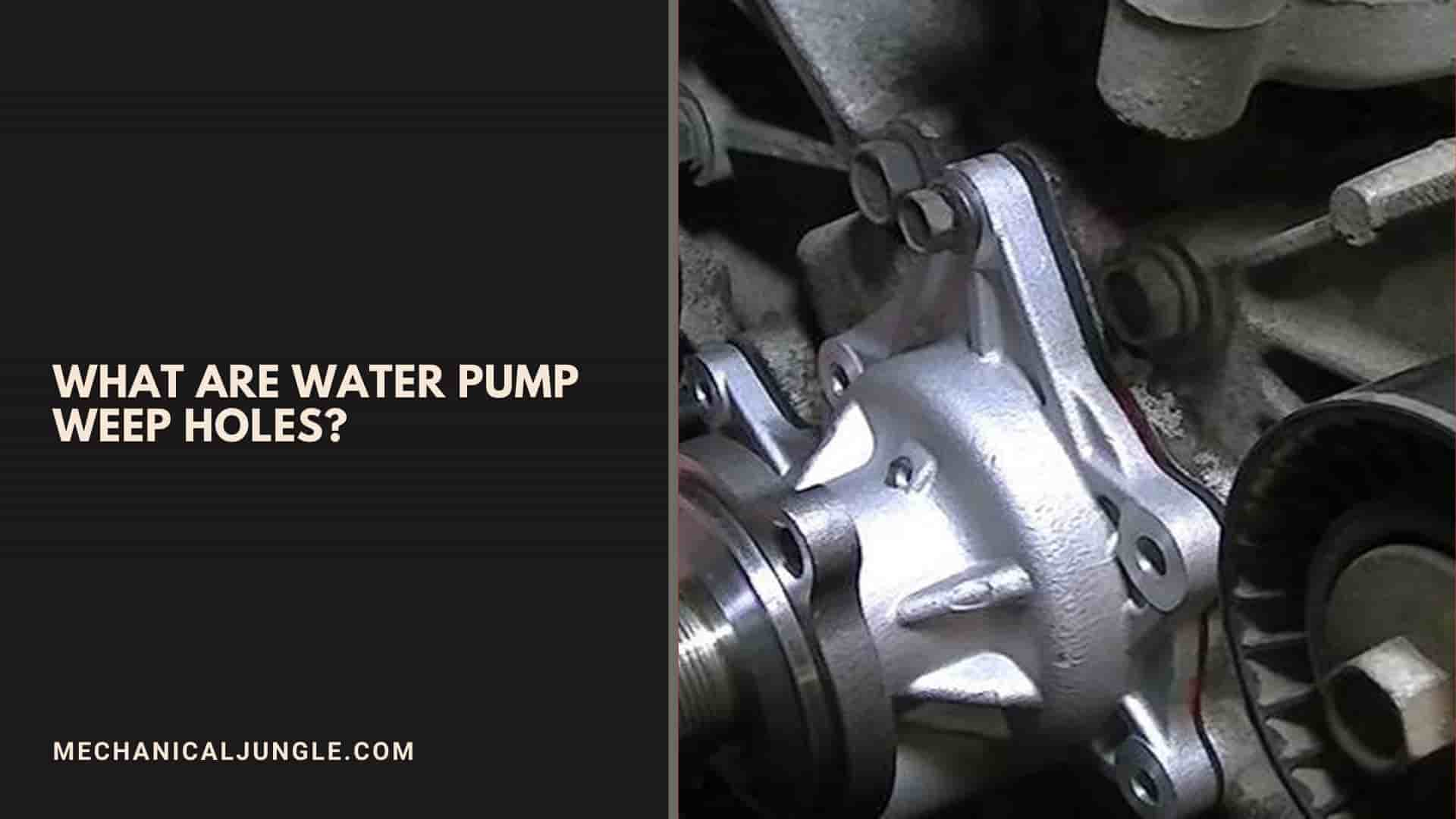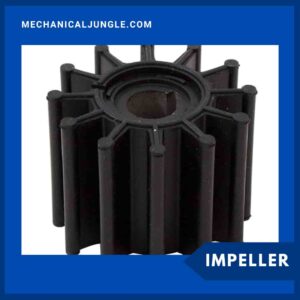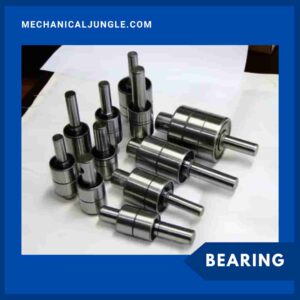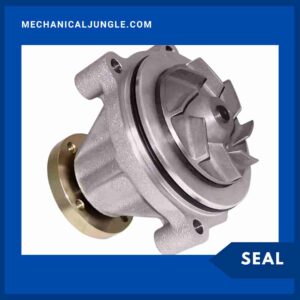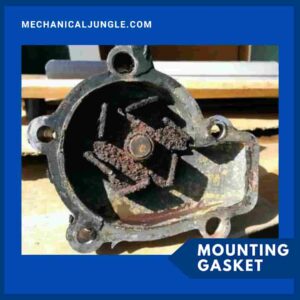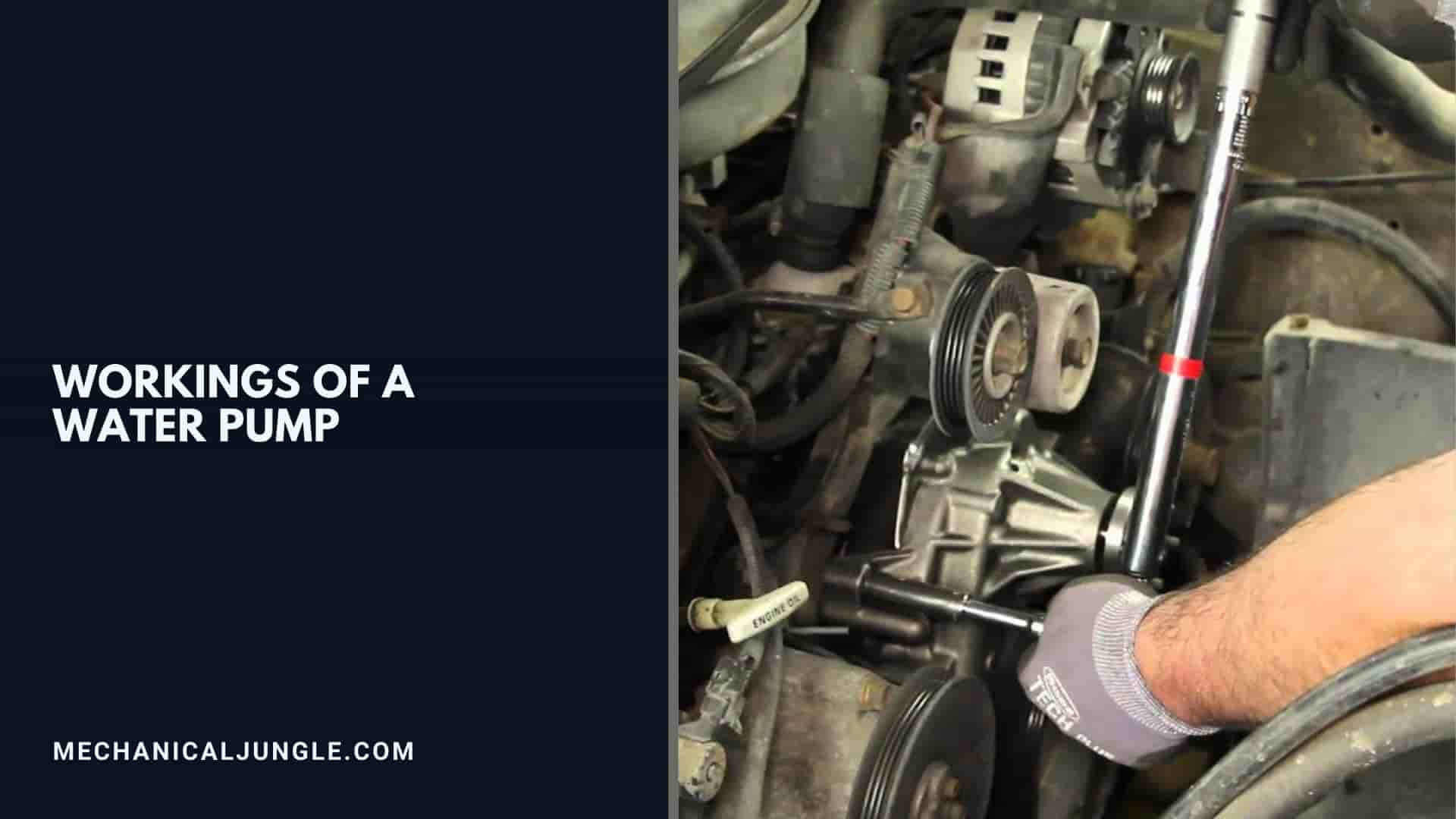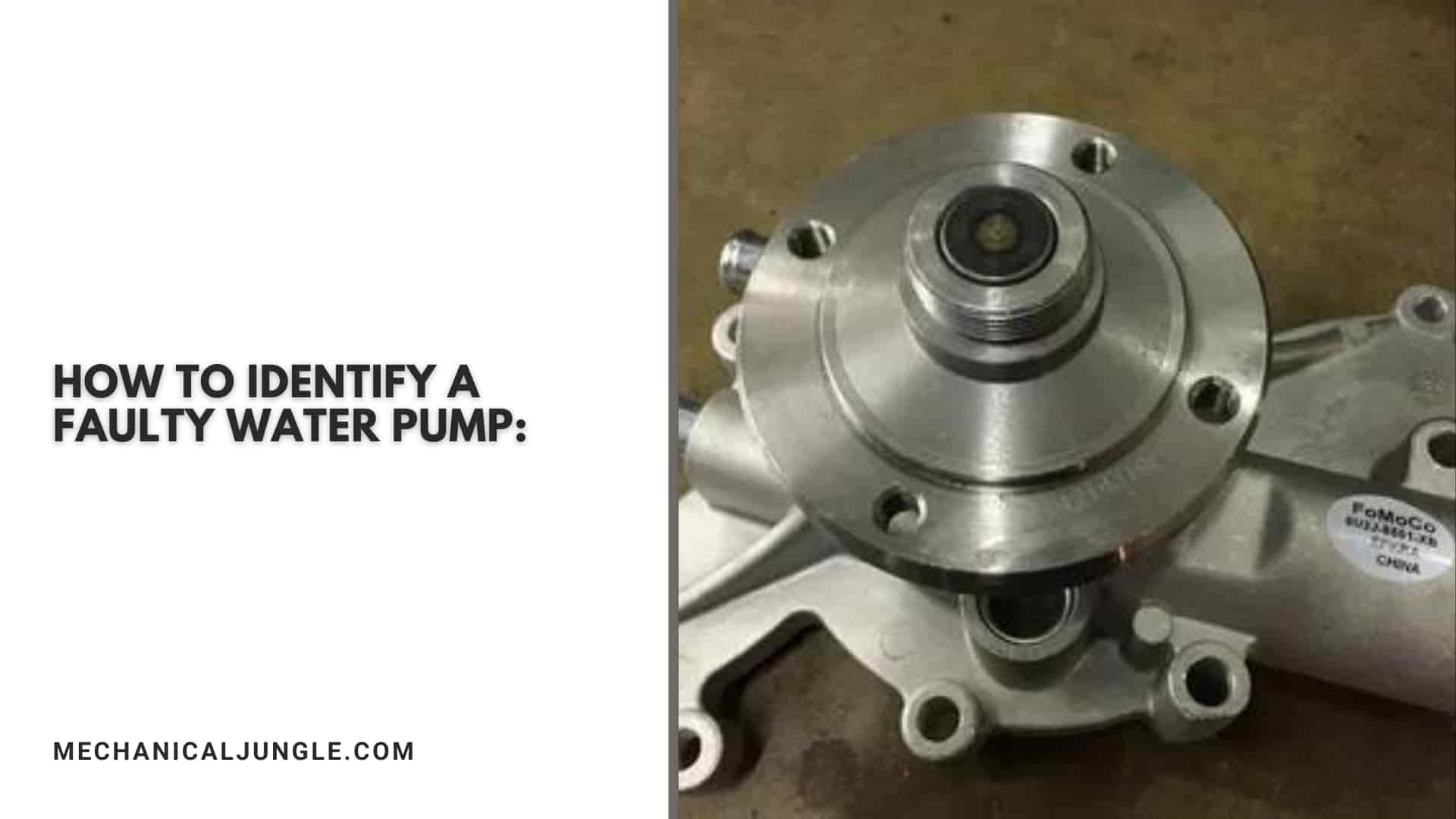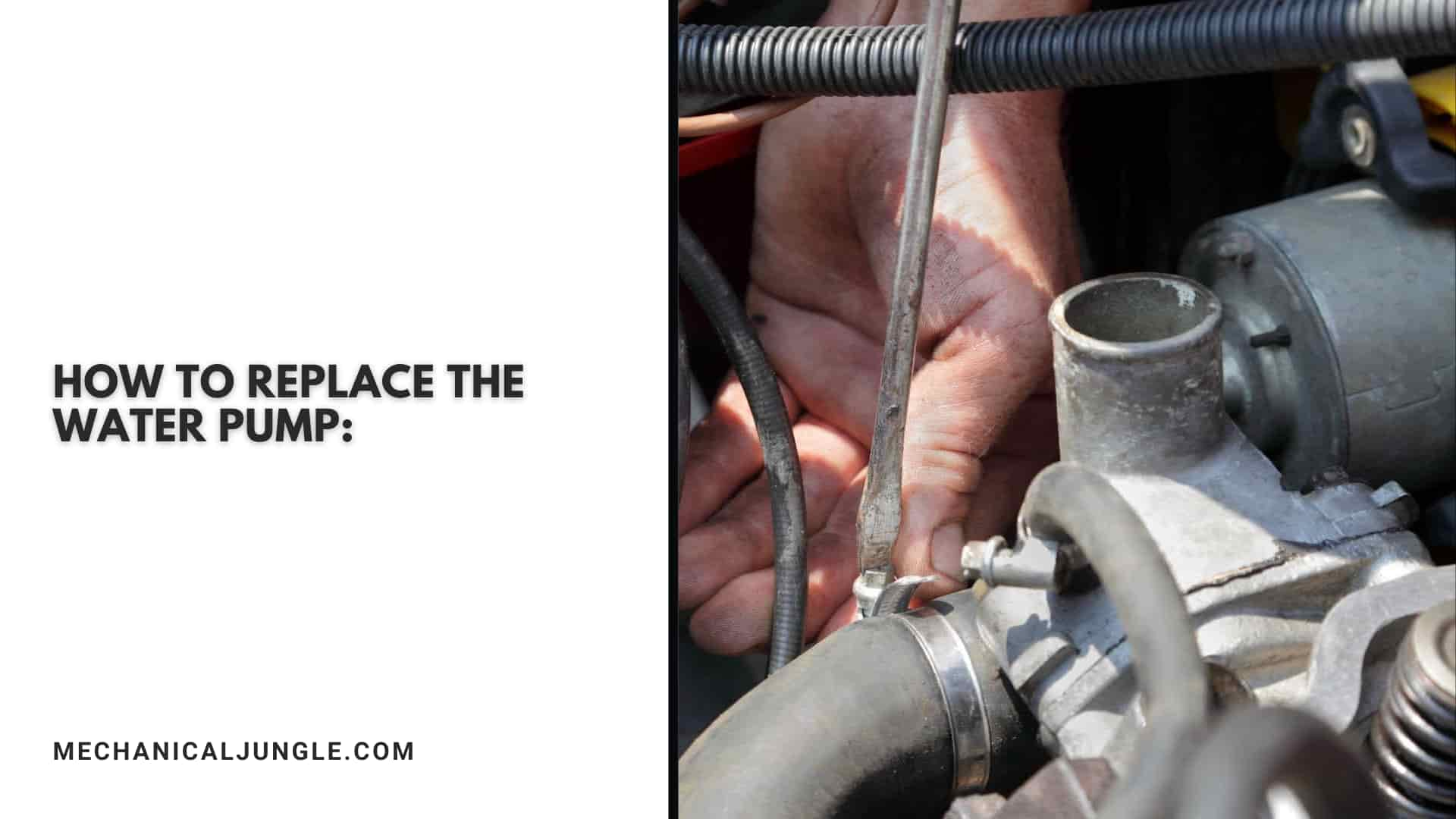Important Point
What Is a Car Water Pump?
A water pump is a mechanical device designed to circulate coolant through a water-cooled engine. Although not all water-cooled engines use a water pump, these components are at the heart of almost all modern water cooling systems.
Water pumps typically operate through rotation of the crankshaft, although this can be accomplished in a variety of ways.
Several different styles of pumps are also commonly used. Your car’s water pumps are the key to keeping the entire system working.
This is an impeller pump and is usually buried under the timing belt cover on the side of the motor.
The blades on the pump allow coolant to flow through the engine and back to the radiator by a forced-air cooling fan.
Also, Read: What Is Timing Belt? | Timing Belt Safety | How Much Is a Timing Belt? | Can I Replace My Own Timing Belt?
How Does a Water Pump Work?
The fan belt turns only when the engine is running. At this point, the central axis of the pump also turns.
When the central axis turns, the petal-like bulges also turn and, using centrifugal force; this creates suction.
This allows the pumps to receive water from the radiator and then send it to the engine through hoses.
The water then absorbs the heat generated by the engine and goes back to the radiator, where it is cooled.
The water pump that plays a key role in cooling the surrounding components is typically composed of six blades and may also increase the flow of coolant by shrouding the bottom of the impeller, although this depends on the type of car.
To ensure long life, water pumps must be properly designed and manufactured to minimize friction and resistance while maximizing flow.
Useful Article For You
- What Is Car Interior Used?
- What Is Transmission
- What Is a Pulley
- What Is an Inverter
- What Is Fluid
- What Is a Flywheel
- What Is a Head Gasket
- What Is Composite
- What Is an Alternator
- What Is a Cvt Transmission
- What Is Earthing
- What Is a Transformer
- What Is a Lathe
- What Is a Spark Plug
- What Is a Strut
- What Is a Boiler
- What Is a Torque Converter
- What Is Milling
- What Is a Map Sensor
- What Is a Radiator
- What Is Tlc in a Car
- What Is a Jig
- What Is a Bolt
- What Is a Screw
- What Is Thermal Pollution
- What Is Annealing
- What Is a Turret
- What Is a Turbine
- What Is a Wheel
- What Is Egr
- What Is a Plane
- What Is a Generator
- What Is a Crankshaft
- What Is a Solar Panel
- What Is a Motor Mount
- What Is a Fastener
- What Is a Spanner
- What Is a Spring
- What Is the Best Head Gasket Sealer
- What Is Motor Vehicle Services
- What Is Gear Oil Used For
- What Is a Brushed Motor
- What Is a Shaft
- What Is an Engine
- What Is a Spread Footing
- What Is a Pitched Roof
- What Is Turbo
- What Is a Condenser
- What Is a Hacksaw
- What Is Flux Core Welding
- What Is a Broach
- What Is a Master Cylinder
- What Is a Gearbox
- What Is a Potentiometer
- What Is a Rack and Pinion
- What Is Taper
- What Is a 4 Cylinder Engine
- What Is a Solar Farm
- What Is Pump Head
- What Is a Subframe on a Car
- What Is the Source of Geothermal Energy
- What Is an Advantage of Using Nuclear Power?
- What Is a Fuel Cap
- What Is the Voltage of a Car Battery
- What Is a Tyres
- What Is a Clamp
- What Is a Comparator
- What Is the Brake
- What Is Welding Used For
- What Is Neutral Flame
- What Is Epb
- What Is Constant Mesh Transmission
- What Is Ball Screw
What Is the Purpose of Water Pump?
At a most basic level, a car’s water pumps are essentially the heart of the cooling system. Its purpose is to continuously circulate engines coolants throughout the cooling system.
The cooling system runs from the radiators to the engine and back to the radiator.
It is this system that allows drivers to enjoy a nice comfortable, quiet car ride. The pump is driven by the engine and is usually driven by means of a belt and pulley system, although a gearing chain may also be used.
The most important components of the pump are the impeller.
The job of the impeller is to spend and circulates the coolers throughout the car. Visually it is similar to propellers that propel the boat.
The impeller can be effective only if it acts on a sealed bearing. If the sealed bearings begin to leak, the water pump will quickly fail.
Also, Read: What Is Automobile Engineering? | Introduction of Automobile Engineering | What Do Automotive Engineers Do?
What Are Water Pump Weep Holes?
Not many people know that a vehicle’s water pump has a weeping hole. There are two holes in the casting of the water pump, which are called vapor holes.
The top row hole acts as an air vent that allows air to evacuate the casting system and prevents a build-up of humidity around the bearing.
It also takes advantage of atmospheric pressure to keep the seal intact. The bottom weep hole is present to allow any fluid that collects around the pump to drain out.
This protects the integrity of the bearings.
History of the Water Pump:
Water pumps predate the invention of an internal combustion engine. Since these external combustions engines were designed to require the constant addition of new waters, these pumps were not engineered to minimize water loss.
The reason these early water pumps were so poorly sealed can be traced largely to the fact that the pump shaft was sealed.
They generally used a lubricated rope seal which by design provided an imperfect seal. And while this was not a problem with steam engines, it quickly became an issue with water-cooled internal combustion engines.
In the early decades of the automobile, water-cooled engines were considered unreliable.
These led to the early success of air cooling, although the problem of naturally leaky water pumps was finally resolved around the time of World War II.
At that time, carbons seal pumps were developed that did not leak nearly as much.
Basic Components of a Water Pump:
#1. Housing
From the name, the housing is what protects and protects the water pump from eternal damage. Most are usually made of aluminum or cast iron, except for modern designs made from stamped steel.
What is referred to weeps hole in the housing allows coolant to escape through a faulty seal.
The housing is therefore critical to ensure that the coolant does not wrap into the bearing assembly & cause permanent damage to the engine.
The vapor hole is located between the pump seal and the hub.
#2. Impeller
The impeller is attached to the bottom of the shaft inside the housing. The main functions of the impellers are to distribute the coolant by means of spinning.
The rate of spinning of the impeller is determined by the RPM of the vehicle.
It is usually made of plastics or metal. Metals impellers tend to last longer than plastics impellers, and most manufacturers prefer to use them when building water pumps.
#3. Bearing
Bearing is the mechanical support that enables the shaft to move continuously in a steady state.
Shafts ride against the bearing with a hub connected at the top and an impeller at the bottom.
#4. Pulley or Hub
This is essentially the power source for the impeller. Therefore, it facilitates the rotation of the impeller and is considered very important.
The V-belt, timing belt, and engine serpentine are also attached to the hub or pulley.
#5. Seal
The seal is important to prevent contamination of the bearing and leakage of coolant by going around the shaft.
Once the seal fails, you will be able to see coolant leaking out of the vehicle when the engine is running.
#6. Mounting Gasket
The mounting gasket serves one elementary simple; Sealing the engine with a water pump.
Workings of a Water Pump:
A typical water pump will move approximately seven thousand five hundred gallons of coolant every hour.
The water pump is also capable of recirculating coolant more than twenty times per minute throughout the engine’s components.
Did you know that at these speeds, your water pump can empty the entire pool in just one hour? I’m betting you didn’t know yet how powerful a water sump pump is.
It is also important to notice that your water pump will work in relation to your engine.
This means it pumps less at slow speeds and more at high speeds.
When your engine speed increases, the amount of heat also produced increases, and the water pump is expected to counter the sudden increase. Therefore, rotational speed will need to be increased to provide the required coolant flow to the impeller.
It is therefore important to inspect the coolants, water pump & belt drive system during each car servicing to ensure that the cooling system does not fail during the trip as it can leave you stranded.
Coolant is drawn from the engine block to the water pump & quickly directed to the radiator. In the radiators, the coolant passes through smalls thin tubes to provides a wider surfaces area to cool the hot fluid in the engine.
This coolant then flows back to the block and engine cylinder head to draw the excess heat generated by the engine. This process is continued by pumping water throughout until the engine stops running.
Eventually, your water pump will fail, and you will need to replace it as soon as possible to avoid permanently damaging your engine.
Remember that replacing a car engine is very expensive and will cost you a lot of money. On the other hand, replacing water pumps doesn’t cost much, and the process only takes an hour or two.
Also, Read: What Is Firing Order? | Why Do We Need Firing Order? | Need of Firing Order in Multicylinder Engine
Useful Article For You
- Headliner in Car
- Alternator Vs Generator
- Axle Seal Leak
- What Is Cast Iron
- Car with Lock Symbol
- What Is an Automobile
- How Does a Magneto Work
- What Is Hydropower
- What Is a Misfire
- What Is Arc Welding
- Flight of Stairs
- Types of Cranes
- Cam and Follower
- Disc Brakes Work By
- Screw Jack
- Car Shaking When Idle
- Beater Car
- Service Battery Charging System
- Types of Hammers
- Resonator Delete
- Rivet Definition
- Coolant Leak Repair Cost
- 6.0 Vortec
- Battery Saver Active
- File Tool
- Cheapest Place to Get Brakes Done
- Tire Feathering
- Ecm Motor
- Service Stabilitrak Chevy Cruze
- Nut Vs Bolt
- Ship Engine
- Interstate Car Battery
- Hvac System Diagram
- Keyless Remote Battery Low
- What Is a Girder
- Shaded Pole Motor
- Mechanical Engineering Companies
- Cv Joint Noise When Driving Straight
- Cnc Bdsm
- Egr Vacuum Solenoid
- Can You Mix Red and Green Coolant
- Reaction Turbine
- Tin Snips Vs Aviation Snips
- Electrical Phases
- Service Steering Column Lock
- Low Power Steering Fluid Symptoms
- Pipe Joints
- Best Welding Schools
- 168 Vs 194 Bulb
- What Is a Coupling
- Dog Clutch
- Beater Cars for Sale
- Does Radiator Stop Leak Work
- How to Reset Fuel Gauge
- Turboshaft Engine
- 5g Welding Position
- Mevotech Vs Moog
- Nuclear Power Plant Parts
- Water Cooled Condenser
- Scotch Yoke Mechanism
- Different Types of Airplanes
- How to Use Bolt Cutters
- Air Lift Pump
- Types of Dimensions
- How to Clean Fuel Pump Without Removal
- Car Roof Leak Repair
- Mechanic Nails
- Scotch Marine Boilers
How to Identify a Faulty Water Pump:
#1. Overheated Engine
These are obvious mosts symptom and the easiest to recognize from everyone else. A faulty pump will prevent your engine from cooling down simply because the coolant is not circulating properly throughout your engine and its various components.
You need to regularly inspect the temperature gauge located on the dashboard of your car whenever you go out for a drive.
Temperatures gauges will rise when the engine is warm, and you should be able to identify them easily.
There is also a temperature warning light located on the dashboard, which is designed to illuminate when the engine is overheated.
The two indicators are hard to miss, & you’ll spot them almost immediately.
#2. Sound
Loose belts will cause a buzzing or moaning sound from the area in front of your car. This causes the wear sound you hear when the belt rotates.
A loose pulley or worn-out bearing may be the most likely reason why your belt is loose and needs to be replaced.
Repairing water pump bearings is considered impractical and costly, and therefore it is advisable to just buy a new one.
Repairing the bearings is never a permanents solution, and after a while, you may find that you are having water pump problems again.
If the buzzing noise intensifies when accelerating, then you should see a professional mechanic soon as it could be engine damage.
#3. Radiator Steam
Another immediate indicator of a faulty water pump is steam coming from the front side of your vehicle. Water needs to circulate to your radiator and cool it.
Bad water pumps will not sufficiently cool your radiator and therefore heat the water to produce steam that will escape from the front end of your car.
Once you see smoke coming out of your vehicle, do not continue to drive. You could cause irreversible damages to your engine and be forced to buy a new one.
Seek immediate help from a professional mechanic and get your water pump repaired.
#4. Fluid Leak
Fluid leaking from your engines while driving is an indicator of a bad water pump. The seal is broken, & the coolant leaks out, preventing it from entering the shaft and causing permanent damage.
Remember that fluid leaks only when your engine is running and stops immediately when the engine stops.
You will need to take your vehicle in for servicing and check the water pump immediately.
#5. Bouncing Temperature Gauge Reading
The temperature reading should always remain in a stable normal state while the engine is running.
Should you notice a sudden shift from low to high and high to low, there is a problem with your radiators or water pump.
How to Replace the Water Pump:
Once the water pump goes bad, it is important for you to get a new one for a replacement to ensure the proper operation of your car.
Below are the necessary steps that will aid in replacing the water pump appropriately. Firsts thing you need to do is find a water pump that is suitable for your car. Then, you should turn off the engines of your car.
It makes sure the engine has completely cooled down when you are about to start replacing the pump. Then you should locate the car battery.
In this case, make sure you have disconnected the battery ground. The second thing you need to do is install a drain pan under the engine.
Then, you should remove the contents of the cooling systems. In this case, you should be sure that cooling compartments are completely drained.
The thirds thing you need to do is find the alternator mounting brackets. You should then loosen them to remove the drive belt.
To open them, you can use the appropriately sized socket and lift them away. Then, you should clear any clutter or stuff out of the way of the water pump.
Then, you should access it by removings the engine pulley, fan, and fan shroud. After that, you should use the hose of the water pumps. To do these, you can use sockets or a wrench.
You should loosen the screw and remove the water pump from the engine. Keep it away from your work area. Look at the engine block and inspect it. If you need cleaning with a cloth, then you should clean it. The fifth thing you should do is replace the water pump gaskets if you find that they are damaged or brokers.
Then, you should line up the new waters pumps & replace them with the old pump’s old one. In doing so, you should consult the manual to double-check so that you are doing the right thing.
Then, you need to properly bolt the water pump to a certain pressure.
The next thing you should do is reconnect the water pumps hose. You should also put anything else you remove back. In this case, you must ensure that belts are properly adjusted to the tension specifications of the car.
The last thing you should do is refill the car’s cooling system.
In these cases, you can upgrade to a better coolant product or antifreeze.
Then, you should plug the battery back in and start your car.
Make sure you inspect to make sure everything is running fine. With this, you wills are ables to replace your water pump properly.
Frequently Asked Questions (FAQ)
How Does Water Pump Work?
So how does a water pump work, you may ask? These pumps use a piston or a turbine to produce a partial vacuum to draw the water out of the well. The same piston or turbine is then used to increase the pressure of the water. This pressure, in turn, pushes the water out of the pump and down the pipes.
What Does a Car Water Pump Do?
A water pump is a vital part of your car, truck, or SUV’s cooling system. Its primary purpose is to continually circulate coolant from the radiator to the vehicle’s engine block to prevent overheating. Modern water pumps are much more robust, but there is still a chance they could fail after many years or miles.
Water Pump Purpose in Car
A water pump is a vital part of your car, truck, or SUV’s cooling system. Its primary purpose is to continually circulate coolant from the radiator to the vehicle’s engine block to prevent overheating.
Water Pump Car Purpose
The water pump is vital to the operation of a car engine as it ensures that coolant flows through the cylinder head, radiator, hoses, and cylinder block and maintains the optimum automotive operating temperature; it is usually driven by a belt from a crankshaft pulley or sprocket.
What Is a Water Pump in a Car?
A vehicle’s water pump is a belt-driven pump that derives its power from the engine’s crankshaft. Designed as a centrifuge, the water pump draws the cooled fluid through the pump’s center inlet from the radiator. It then circulates the fluid outward into the engine and back into the car’s cooling system.
How Much to Fix Water Pump in Car?
The cost for replacement of the water pump varies greatly depending on the size, make, and age of the car, though you can expect to pay anywhere from $310 to $730 total.
Like this post? Share it with your friends!
Suggested Read –
- Gear Pump Diagram
- Steam Turbine Condenser
- Centrifugal Casting Process
- Components of Front Axle
- How Do Aircraft Brakes Work | How Aircraft Brakes Work | Brake Design | Aircraft Brakes
- Lancashire Boiler | Lancashire Boiler Diagram | Steam Boiler Working Principle | Steam Boiler Parts and Function
- What Is Forming | Types of Forming | Forming Process in Manufacturing | Metal Forming Processes | Forming Operations
- What Is Boliler? | Types of Boiler | Steam Boiler | How Boiler Work | Boiler Operation | Boilers Diagram | How Does a Steam Boiler Work
- What Is Sigma Comparator | Construction of Sigma Comparator | Applications of Sigma Comparator | Advantages of Sigma Comparator | Disadvantages of Sigma Comparator
